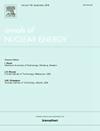Thermal hydraulic deformation analysis of fine 5 × 5 rod bundle fuel assembly based on multi-field coupling
IF 1.9
3区 工程技术
Q1 NUCLEAR SCIENCE & TECHNOLOGY
引用次数: 0
Abstract
This paper proposes a new multi physics field simulation method that integrates computational fluid dynamics, fluid structure coupling, and heat transfer theory for comprehensive analysis of complex reactions inside nuclear fuel cores. The methodology enables precise modeling of a 5 × 5 rod bundle fuel assembly, considering temperature-dependent material properties and non-uniform thermal convection. A bidirectional coupling analysis is conducted to explore the intricate interactions between thermal, fluid, and solid domains. The transient simulation, spanning 5 s, reveals a maximum displacement of 3.3 μm in fuel rods, with a cloud map highlighting temperature gradients and distinct deformations along radial and height directions. This research presents a feasible and efficient framework for importing and simulating three-dimensional fine models, yielding crucial displacement data pertinent to the thermal–hydraulic performance of fuel components. Its findings carry substantial engineering value for advancing nuclear reactor research, design optimization, and safe operation.
求助全文
约1分钟内获得全文
求助全文
来源期刊

Annals of Nuclear Energy
工程技术-核科学技术
CiteScore
4.30
自引率
21.10%
发文量
632
审稿时长
7.3 months
期刊介绍:
Annals of Nuclear Energy provides an international medium for the communication of original research, ideas and developments in all areas of the field of nuclear energy science and technology. Its scope embraces nuclear fuel reserves, fuel cycles and cost, materials, processing, system and component technology (fission only), design and optimization, direct conversion of nuclear energy sources, environmental control, reactor physics, heat transfer and fluid dynamics, structural analysis, fuel management, future developments, nuclear fuel and safety, nuclear aerosol, neutron physics, computer technology (both software and hardware), risk assessment, radioactive waste disposal and reactor thermal hydraulics. Papers submitted to Annals need to demonstrate a clear link to nuclear power generation/nuclear engineering. Papers which deal with pure nuclear physics, pure health physics, imaging, or attenuation and shielding properties of concretes and various geological materials are not within the scope of the journal. Also, papers that deal with policy or economics are not within the scope of the journal.
 求助内容:
求助内容: 应助结果提醒方式:
应助结果提醒方式:


